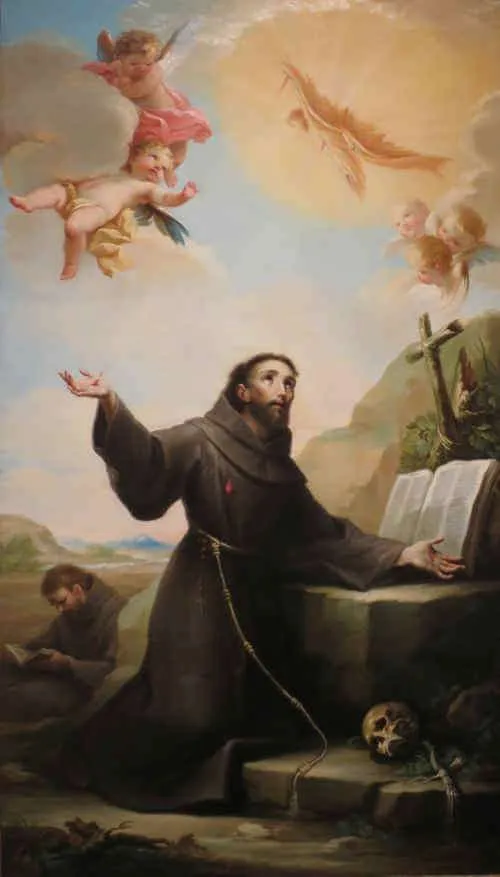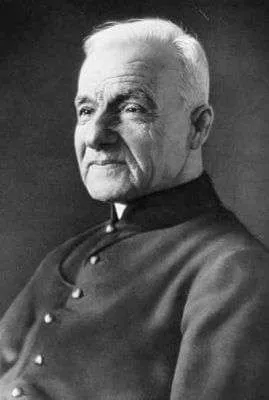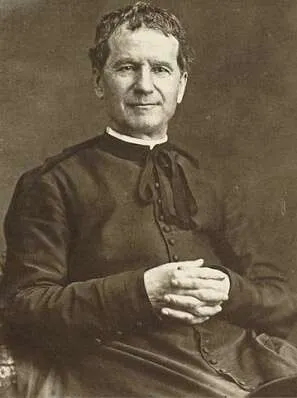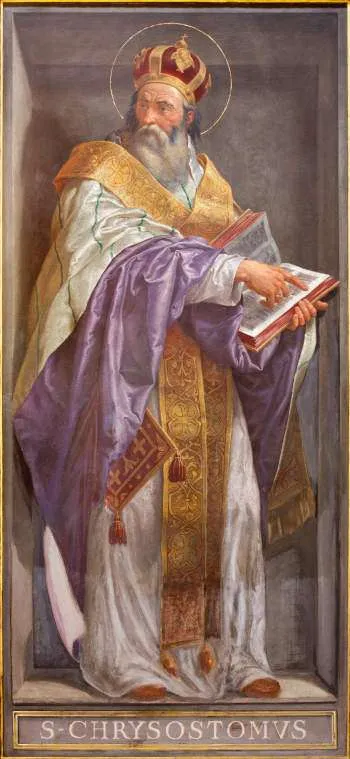1182–1226; Patron Saint of animals, ecologists, families, lacemakers, merchants, needleworkers, peace, and zoos; Invoked against dying alone and fire; Canonized by Pope Gregory IX on July 16, 1228
Saint Francis of Assisi is perhaps the most known and loved saint within the Catholic Church. Though many flock to him because of his portrayal as one who loved animals and nature, he became one of the greatest saints in history for one simple reason: he was a true servant of the Most High God.
Francis of Assisi was most likely born in the year 1181 in the small town of Assisi, Italy, about 100 miles north of Rome. He was born into the merchant class, his father being a seller of fine silk. As a youth, Francis was known to be quite lively, often the center of attention among friends. As a teenager, he enjoyed parties and singing and was quite worldly.
His father wanted Francis to join him in the family business, which Francis did with disinterest. He was far more interested in his friends and in having a good time than he was in work. This caused tensions at home on a regular basis.
As a young adult, Francis had dreams of doing great things. However, the “great things” he dreamt of had much more to do with obtaining worldly honors than with honoring God. One of his chief desires was to become a great knight. His family also desired he become a knight so that their societal status would be elevated.
Around the year 1202, Francis’s dream of becoming a great knight began to move forward. He was fitted with fine armor, a sword, and a horse and sent into battle against the neighboring town of Perugia. Success in that battle would prepare him to one day become a Crusader in the pope’s army, hopefully earning him the dignity of a knight. But the battle of Perugia was short and ended in Francis’ capture and imprisonment. As Francis waited a year for his father to pay the ransom for his release, he suffered greatly with the other men who were imprisoned.
After his release, Francis spent months with a serious illness. Both his imprisonment and illness affected him greatly, and he began to reevaluate his life. Despite that, in 1205 he set off for another battle in the army of the Count of Brienne, once again well fitted with a horse, sword, and armor. Before he arrived, however, Francis had a vision that would change his life. In that vision, Francis heard a voice say to him, “Who can do more for you? The master or the servant? The rich man or poor man?” Francis quickly answered, “The rich master!” The voice then asked, “Then why do you leave the Lord for the servant and the God of infinite riches for the poor mortal?” This vision was enough for Francis to turn around and return to Assisi in search of God’s will.
Over the next year, Francis and his father regularly were at odds. Francis began to pray and seek God’s will for his life, while his father continued to insist that Francis become a knight or work in the family business. During that year, Francis grew in his love for the poor and even served the lepers at a nearby hospital. While praying one day in the dilapidated Church of San Damiano, Francis heard a voice from Heaven say to him, “Go, repair my house which, as you see, is falling completely to ruin.” With that, he began to physically repair that church, live in solitude, and pray continually.
The family conflict between Francis and his father came to a head in 1206 when Francis was twenty-five years old. He and his father formally parted ways in the presence of the Bishop of Assisi when Francis renounced his inheritance, choosing only God as his Father. Over the next three years, Francis began to live his new life of poverty, prayer, and service of God.
At first, most of the townspeople thought Francis was out of his mind, and they ridiculed him. But as time passed, Francis began to attract some followers. He and his followers spent much time praying, listening to the voice of God, serving the poor and lepers, and working with their hands to repair abandoned churches.
By the year 1209, Francis and his followers numbered twelve. They decided to write a new Rule for their common life and made a pilgrimage to Rome to get papal approval for their Rule. Once the pope verbally approved their Rule, Francis and his companions returned to Assisi and took up residence in a small church called the Portiuncula. From there, Brother Francis and his Friars Minor began their life of prayer and missionary preaching. Now, instead of rebuilding physical churches, they began to rebuild God’s Church, the spiritual Body of Christ.
Over the next ten years, the Order of Friars Minor grew from only twelve to about five thousand. They took up residence across Europe and began to have a powerful effect upon many people. Francis continued to preach and was also the instrument of countless miracles. In 1223, the pope approved the final and definitive Rule of the Friars Minor in writing, and Francis entered into the final years of his life.
In 1224, while on a forty-day retreat, Francis was gifted with the stigmata, the visible wounds of Christ in his hands, feet, and side. Those final two years were also marked with much suffering from various illnesses and the loss of his sight.
On October 4, 1226, after being unable to find a cure for his many illnesses, Saint Francis died surrounded by his brothers in Assisi at the Portiuncula where his life as a Friar Minor began. Just two years later, Pope Gregory IX canonized him as a saint, and his legacy continued to grow.
Saint Francis was unquestionably one of the greatest saints to ever live. The way he accomplished this greatness is worth studying and imitating. Though it is hard to imagine ourselves ever reaching the heights of sanctity that Saint Francis achieved, know that it is possible for us all. Saint Francis embraced the will of God with a radical abandonment and ongoing zeal. This resulted in his becoming one with Christ and doing great things for God and His Church in a very short period of time.
Source: https://mycatholic.life/saints/saints-of-the-liturgical-year/october-4–st-francis-of-assisi/







